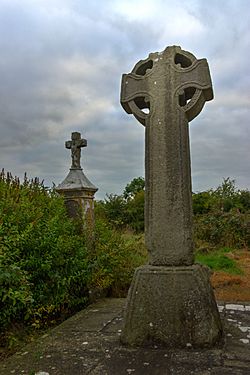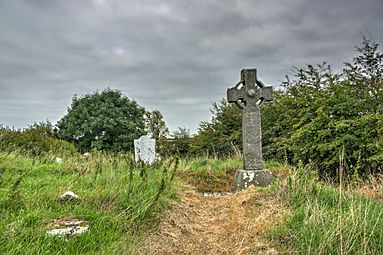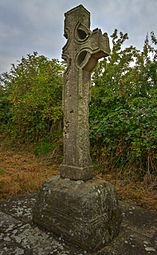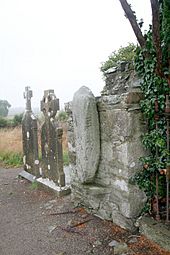Castlekeeran facts for kids
| Díseart Ciaráin | |

North Cross
|
|
| Monastery information | |
|---|---|
| Other names | Castlekieran Bealach-duin |
| Established | 8th century |
| Diocese | Meath |
| People | |
| Founder(s) | Ciarán the Pious |
| Architecture | |
| Style | Celtic monasticism |
| Site | |
| Location | Carnaross, County Meath, Ireland |
| Coordinates | 53°44′28″N 6°57′16″W / 53.741042°N 6.954343°W |
| Public access | yes |
| Official name | Castlekeeran Crosses |
| Reference no. | 107 |
Castlekeeran is an old monastery site in County Meath, Ireland. It is now a National Monument, which means it's a very important historical place protected by the country.
Contents
Where is Castlekeeran?
Castlekeeran is located in County Meath, Ireland. You can find it about 1.1 kilometers (or 0.7 miles) south of a village called Carnaross. The site sits right on the south bank of the Leinster Blackwater river. Today, it is mostly a walled graveyard.
A Look at Castlekeeran's Past
Castlekeeran monastery was founded a very long time ago. It was started by a person known as Ciarán the Pious. He died in the year 770.
Over the centuries, the monastery faced some challenges.
- In 949, Vikings attacked the monastery. Vikings were warriors and traders from Northern Europe.
- Later, in 1170, Diarmait Mac Murchada raided the site. He was a powerful Irish king.
- After these events, the monastery came under the control of the Knights Hospitaller. They were a famous group of Christian knights.
- Much later, during the Dissolution of the Monasteries, the site was taken over by the government. This happened when many monasteries in Ireland and England were closed down.
- Finally, the land passed to the Plunket family.
What Can You See at Castlekeeran?
Castlekeeran is known for some amazing old stone carvings.
Tall Stone Crosses
There are three large sandstone high crosses at the site. These are tall, decorated stone crosses that were common in early Christian Ireland. They often have carvings of Bible stories or Celtic designs.
There's also a story about a fourth cross. Legend says that Columba, another famous Irish saint, tried to take the cross. But Ciarán caught him, and Columba quickly dropped the cross into the river.
These crosses are called termon crosses. The word termon comes from an old Irish word meaning "border." These crosses marked the sānctissimus, which was the holiest part of the monastery, usually around the church.
- Castlekeeran
The Ogham Stone
You can also see an Ogham stone at Castlekeeran. An Ogham stone is a tall stone with an ancient Irish alphabet carved into its edges. This alphabet is called Ogham.
The Ogham stone at Castlekeeran has an inscription that reads: "COVAGNI MAQI MUCOLI LUGINI." This means "Cuana son of the people of Luigni." The Luigni were a group of people known in Meath from the 700s onwards. They even gave their name to a local area called the barony of Lune.





